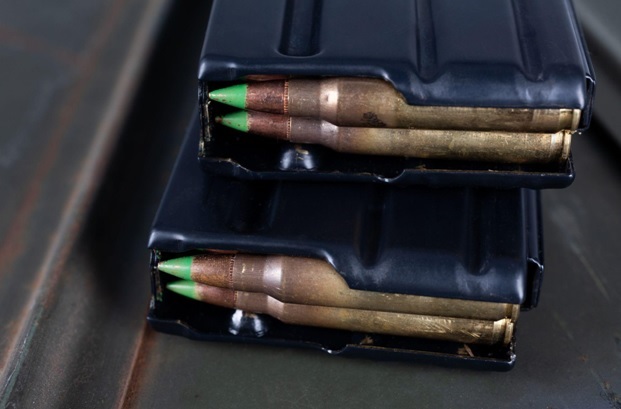We all know that person at the range that says something like “.223? 5.56? They’re the same cartridge!” and then boldly spends the next hour or two burning through a bucket of each through the same gun.
As wanton as this may seem, “that person” has a point, but they’re missing the mark, if you can excuse the pun.
Cartridges like Federal .223 and 5.56 are, indeed, very similar, but they are not quite the same.
Here’s what you need to know about these two related cartridges, along with a few myths and facts about them.
History of .223 Remington and 5.56 NATO
Beginning in the 1950s, the United States Army began outlining requirements for their next generation rifle.
The .30-06 and 7.62 NATO cartridges that soldiers had been carrying and firing through platforms like the M1 Garand and M14 rifles were just too heavy and too cumbersome, despite their ballistic performance and advantages.
The Army wanted a new rifle built around a .22 caliber cartridge that would remain supersonic at 500 yards and which could still penetrate a steel helmet at the same distance.
The new cartridge would also have to offer similar ballistics to .30-06 while retaining the lethality of the .30 Carbine cartridge.
Remington Arms spearheaded the development of the cartridge, beginning in 1957 and culminating in the release of the .223 Remington cartridge in 1962.
The Army required slightly different specifications for ammunition to be paired with the rifle developed around the same time - calling for the development of the 5.56x45mm NATO.
The parent cartridge of the 5.56 NATO actually is the .223 Remington, making them almost indistinguishable from each other; but they are not actually exactly the same.
The external dimensions of the two cartridges are basically the same. They only become apparent when you take a closer look at the case rim.
The 5.56 cartridge is typically manufactured with a date code; also, 5.56 is manufactured with a crimped primer pocket. This ensures that the primer won’t accidentally back out during full-auto firing.
As for the cases and cartridge load specifications, these are slightly different between the two, as well. The .223 Remington is loaded to a max pressure of about 55,000 PSI, whereas the 5.56 has a higher working pressure specification of about 63,000 PSI.
The chamber dimensions are different, too, albeit minimally. In 5.56 chamberings, the base diameter, shoulder diameter, and base-to-shoulder distances are all slightly (a few thousandths of an inch) longer.
The freebore in 5.56 chamberings is also slightly larger and about twice as long as .223 chamberings
So, Let’s Talk Some Myths
With all of that said, let’s take a closer look at some of the most pervasive myths associated with these two cartridges.
Myth 1: These Cartridges Are Interoperable
False! The best rule of thumb to follow is only to shoot ammunition rated for the rifle by the manufacturer.
Due to the higher case pressures, 5.56 ammo can only be shot through a 5.56 rifle. However, .223 can be fired through either a rifle chambered for .223 Remington or 5.56 NATO.
Myth 2: You Need Different Reloading Essentials
Not entirely. Since the cartridge casings are effectively identical, much of what you’ll need for reloading 5.56 and .223 cartridges is the same.
They can both be reloaded using the same shell holder, powder, press, and so on and so forth.
Here are two things you will need to note:
One, you may need a special tool to remove the primer from 5.56 ammo, since it is crimped.
Two, load data for the two is not the same so make sure you are referencing appropriate materials.
Myth 3: Only .223 Is Used in MSRs
False, there are modern sporting rifles (like the AR-15) chambered for both of these cartridges.
Myth 4: You Can’t Use the Same Magazines for Each

False. Since the external dimensions of the cartridges are effectively identical, a magazine that will accept and feed one will feed the other.
However, be sure you note what is loaded in your magazine, as it is not safe to fire 5.56 ammunition through a .223 rifle.
Myth 5: .223 Wylde Is the Same as 5.56
False; however, .223 Wylde was developed as a hybrid chamber that could handle either round. Therefore, though it is not the same as 5.56, rifles chambered in .223 Wylde can fire both cartridges.
Myth 6: One Is More Accurate Than the Other
This is difficult to qualify, as many guns will favor one rifle ammunition or brand over the other. Things like barrel twist rate and barrel length will also impact accuracy.
Neither is inherently more accurate than the other.
Get Your TulAmmo, Remington, and Federal .223 and 5.56 Here
Now that you know some of these key differences between the .223 Remington and 5.56x45mm NATO cartridges, you can set your friends straight at the range.
Before you get there, though, check out our selection of TulAmmo, Remington, Federal .223 and 5.56 ammo, perfect for high-volume shooting, target practice, and competition. Many of them are even loaded into reloadable brass cases so you can keep and reload your spent shells.

